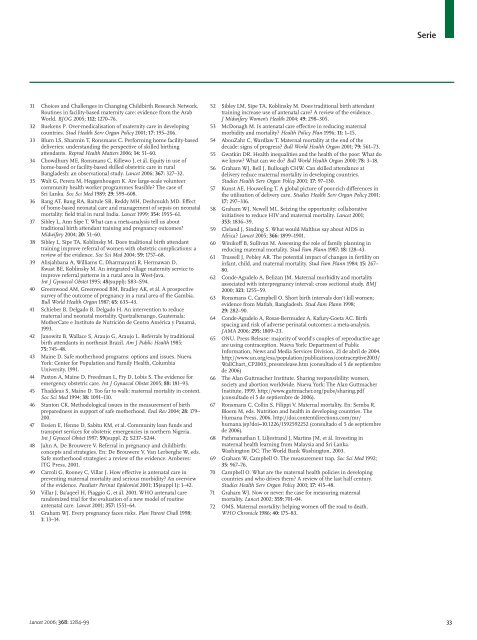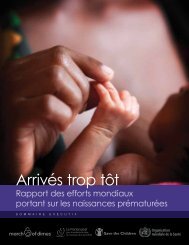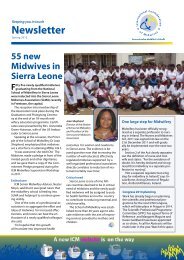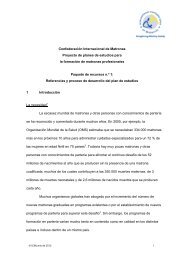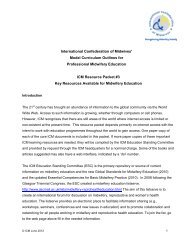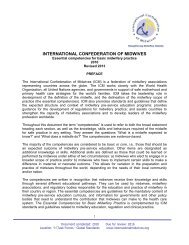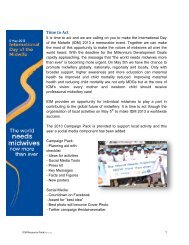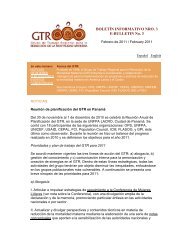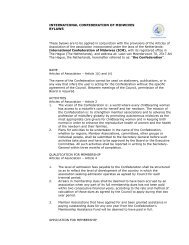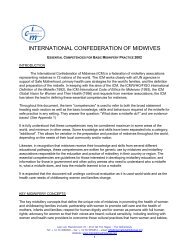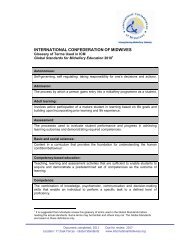Lancet - International Confederation of Midwives
Lancet - International Confederation of Midwives
Lancet - International Confederation of Midwives
Create successful ePaper yourself
Turn your PDF publications into a flip-book with our unique Google optimized e-Paper software.
31 Choices and Challenges in Changing Childbirth Research Network.<br />
Routines in facility-based maternity care: evidence from the Arab<br />
World. BJOG 2005; 112: 1270–76.<br />
32 Buekens P. Over-medicalisation <strong>of</strong> maternity care in developing<br />
countries. Stud Health Serv Organ Policy 2001; 17: 195–206.<br />
33 Blum LS, Sharmin T, Ronsmans C. Performing home facility-based<br />
deliveries: understanding the perspective <strong>of</strong> skilled birthing<br />
attendants. Reprod Health Matters 2006; 14: 51–60.<br />
34 Chowdhury ME, Ronsmans C, Killewo J, et ál. Equity in use <strong>of</strong><br />
home-based or facility-based skilled obstetric care in rural<br />
Bangladesh: an observational study. <strong>Lancet</strong> 2006; 367: 327–32.<br />
35 Walt G, Perera M, Heggenhougen K. Are large-scale volunteer<br />
community health worker programmes feasible? The case <strong>of</strong><br />
Sri Lanka. Soc Sci Med 1989; 29: 599–608.<br />
36 Bang AT, Bang RA, Baitule SB, Reddy MH, Deshmukh MD. Effect<br />
<strong>of</strong> home-based neonatal care and management <strong>of</strong> sepsis on neonatal<br />
mortality: field trial in rural India. <strong>Lancet</strong> 1999; 354: 1955–61.<br />
37 Sibley L, Ann Sipe T. What can a meta-analysis tell us about<br />
traditional birth attendant training and pregnancy outcomes?<br />
Midwifery 2004; 20: 51–60.<br />
38 Sibley L, Sipe TA, Koblinsky M. Does traditional birth attendant<br />
training improve referral <strong>of</strong> women with obstetric complications: a<br />
review <strong>of</strong> the evidence. Soc Sci Med 2004; 59: 1757–68.<br />
39 Alisjahbana A, Williams C, Dharmayanti R, Hermawan D,<br />
Kwast BE, Koblinsky M. An integrated village maternity service to<br />
improve referral patterns in a rural area in West-Java.<br />
Int J Gynaecol Obstet 1995; 48(suppl): S83–S94.<br />
40 Greenwood AM, Greenwood BM, Bradley AK, et ál. A prospective<br />
survey <strong>of</strong> the outcome <strong>of</strong> pregnancy in a rural area <strong>of</strong> the Gambia.<br />
Bull World Health Organ 1987; 65: 635–43.<br />
41 Schieber B, Delgado B, Delgado H. An intervention to reduce<br />
maternal and neonatal mortality. Quetzaltenango, Guatemala:<br />
MotherCare e Instituto de Nutrición de Centro América y Panamá,<br />
1993.<br />
42 Janowitz B, Wallace S, Araujo G, Araujo L. Referrals by traditional<br />
birth attendants in northeast Brazil. Am J Public Health 1985;<br />
75: 745–48.<br />
43 Maine D. Safe motherhood programs: options and issues. Nueva<br />
York: Center for Population and Family Health, Columbia<br />
University, 1991.<br />
44 Paxton A, Maine D, Freedman L, Fry D, Lobis S. The evidence for<br />
emergency obstetric care. Int J Gynaecol Obstet 2005; 88: 181–93.<br />
45 Thaddeus S, Maine D. Too far to walk: maternal mortality in context.<br />
Soc Sci Med 1994; 38: 1091–110.<br />
46 Stanton CK. Methodological issues in the measurement <strong>of</strong> birth<br />
preparedness in support <strong>of</strong> safe motherhood. Eval Rev 2004; 28: 179–<br />
200.<br />
47 Essien E, Ifenne D, Sabitu KM, et al. Community loan funds and<br />
transport services for obstetric emergencies in northern Nigeria.<br />
Int J Gynecol Obstet 1997; 59(suppl. 2): S237–S244.<br />
48 Jahn A, De Brouwere V. Referral in pregnancy and childbirth:<br />
concepts and strategies. En: De Brouwere V, Van Lerberghe W, eds.<br />
Safe motherhood strategies: a review <strong>of</strong> the evidence. Amberes:<br />
ITG Press, 2001.<br />
49 Carroli G, Rooney C, Villar J. How effective is antenatal care in<br />
preventing maternal mortality and serious morbidity? An overview<br />
<strong>of</strong> the evidence. Paediatr Perinat Epidemiol 2001; 15(suppl 1): 1–42.<br />
50 Villar J, Ba’aqeel H, Piaggio G, et ál. 2001. WHO antenatal care<br />
randomized trial for the evaluation <strong>of</strong> a new model <strong>of</strong> routine<br />
antenatal care. <strong>Lancet</strong> 2001; 357: 1551–64.<br />
51 Graham WJ. Every pregnancy faces risks. Plan Parent Chall 1998;<br />
1: 13–14.<br />
52 Sibley LM, Sipe TA, Koblinsky M. Does traditional birth attendant<br />
training increase use <strong>of</strong> antenatal care? A review <strong>of</strong> the evidence.<br />
J Midwifery Women’s Health 2004; 49: 298–305.<br />
53 McDonagh M. Is antenatal care effective in reducing maternal<br />
morbidity and mortality? Health Policy Plan 1996; 11: 1–15.<br />
54 AbouZahr C, Wardlaw T. Maternal mortality at the end <strong>of</strong> the<br />
decade: signs <strong>of</strong> progress? Bull World Health Organ 2001; 79: 561–73.<br />
55 Gwatkin DR. Health inequalities and the health <strong>of</strong> the poor: What do<br />
we know? What can we do? Bull World Health Organ 2000; 78: 3–18.<br />
56 Graham WJ, Bell J, Bullough CHW. Can skilled attendance at<br />
delivery reduce maternal mortality in developing countries.<br />
Studies Health Serv Organ Policy 2001; 17: 97–130.<br />
57 Kunst AE, Houweling T. A global picture <strong>of</strong> poor-rich differences in<br />
the utilisation <strong>of</strong> delivery care. Studies Health Serv Organ Policy 2001;<br />
17: 297–316.<br />
58 Graham WJ, Newell ML. Seizing the opportunity: collaborative<br />
initiatives to reduce HIV and maternal mortality. <strong>Lancet</strong> 2001;<br />
353: 1836–39.<br />
59 Cleland J, Sinding S. What would Malthus say about AIDS in<br />
Africa? <strong>Lancet</strong> 2005; 366: 1899–1901.<br />
60 Winik<strong>of</strong>f B, Sullivan M. Assessing the role <strong>of</strong> family planning in<br />
reducing maternal mortality. Stud Fam Plann 1987; 18: 128–43.<br />
61 Trussell J, Pebley AR. The potential impact <strong>of</strong> changes in fertility on<br />
infant, child, and maternal mortality. Stud Fam Plann 1984; 15: 267–<br />
80.<br />
62 Conde-Agudelo A, Belizan JM. Maternal morbidity and mortality<br />
associated with interpregnancy interval: cross sectional study. BMJ<br />
2000; 321: 1255–59.<br />
63 Ronsmans C, Campbell O. Short birth intervals don’t kill women:<br />
evidence from Matlab, Bangladesh. Stud Fam Plann 1998;<br />
29: 282–90.<br />
64 Conde-Agudelo A, Rosas-Bermudez A, Kafury-Goeta AC. Birth<br />
spacing and risk <strong>of</strong> adverse perinatal outcomes: a meta-analysis.<br />
JAMA 2006; 295: 1809–23.<br />
65 ONU. Press Release: majority <strong>of</strong> world’s couples <strong>of</strong> reproductive age<br />
are using contraception. Nueva York: Department <strong>of</strong> Public<br />
Information, News and Media Services Division, 21 de abril de 2004.<br />
http://www.un.org/esa/population/publications/contraceptive2003/<br />
WallChart_CP2003_pressrelease.htm (consultado el 5 de septiembre<br />
de 2006)<br />
66 The Alan Guttmacher Institute. Sharing responsibility: women,<br />
society and abortion worldwide. Nueva York: The Alan Guttmacher<br />
Institute, 1999. http://www.guttmacher.org/pubs/sharing.pdf<br />
(consultado el 5 de septiembre de 2006).<br />
67 Ronsmans C, Collin S, Filippi V. Maternal mortality. En: Semba R,<br />
Bloem M, eds. Nutrition and health in developing countries. The<br />
Humana Press, 2006. http://doi.contentdirections.com/mr/<br />
humana.jsp?doi=10.1226/1592592252 (consultado el 5 de septiembre<br />
de 2006).<br />
68 Pathmanathan I, Liljestrand J, Martins JM, et ál. Investing in<br />
maternal health learning from Malaysia and Sri Lanka.<br />
Washington DC: The World Bank Washington, 2003.<br />
69 Graham W, Campbell O. The measurement trap. Soc Sci Med 1992;<br />
35: 967–76.<br />
70 Campbell O. What are the maternal health policies in developing<br />
countries and who drives them? A review <strong>of</strong> the last half century.<br />
Studies Health Serv Organ Policy 2001; 17: 415–48.<br />
71 Graham WJ. Now or never: the case for measuring maternal<br />
mortality. <strong>Lancet</strong> 2002; 359: 701–04.<br />
72 OMS. Maternal mortality: helping women <strong>of</strong>f the road to death.<br />
WHO Chronicle 1986; 40: 175–83.<br />
Serie<br />
<strong>Lancet</strong> 2006; 368: 1284–99 33


